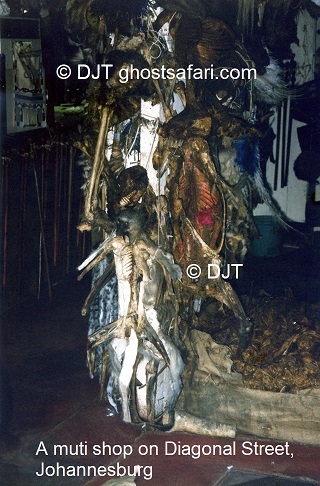The Real Diagon Alley - Diagonal Street
|
All Harry Potter fans know that Harry and his fellow students and wizards buy their magical paraphernalia from the shops and traders in London's Diagon Alley. However, the real Diagon Alley, or Diagonal Street as it is officially known, is in Johannesburg, South Africa. Here, too, the initiated came to buy their magical tools and medicines, or "muti" as it is known in South Africa. These photographs were taken in the 1980s and the scene may have changed. I gather that there are still muti shops there but after Apartheid ended, they sprang up in many other areas of Johnannesburg and Randburg, and Diagonal St lost its virtual monoploly.
Inyangas are traditional healers and herbalists. Sangomas are South African shamans who, among other skills, "throw the bones" to see the future, consult ancestors or diagnose illnesses caused by witchcraft or "tagati". They are also the professionals to consult for protection against the tokoloshe. When it comes to curing illnesses believed to be caused by witchcraft, the functions of inyangas and sangomas overlap but the services of inyangas tend to be more expensive.
The term "witch doctors" for sangomas is sometimes said to be a misnomer but by its nineteenth century definition, the term was accurate. "Witch doctor" never meant "doctor who is a witch". It meant "doctor to consult about witchcraft". Until well into the nineteenth century, rural people in England consulted witch doctors when they believed themselves to be beset by witches or sorcerers. One of the most famous English witch doctors was James "Cunning" Murrell, who died in December 1860.
Also in central Johannesburg, on the corner of Berea and Anderson Streets, was the Mai-Mai Bazaar, a traditional market where sangomas, inyangas and muti sellers, as well as other craftsmen, did business. How it survived the purges of the Apartheid era I do not know, unless it was through the powerful muti of the traders. After Apartheid ended, it lost its importance and many traders moved to a larger space under an overpass. The last time I saw it, in the mid 1990s, the Mai Mai Bazaar was a shadow of its former self. However, I gather that with the help of the council, it has been rejuvenated and now goes by the name of Kwa Mai Mai traditional market. I have read two explanations for how it got its name. According to one, it derives from when the market was part of a miners' compound and it was named after a mine manager who said "my my!" whenever he saw injured workers. The other explanation, which I think is more likely, is that an early council official kept exclaiming "my my!" while inspecting the market and perusing in wonder the goods for sale.
One unfortunate consequence of the end of Apartheid was that there was a period during which it was not always clear what was, de facto, legal or illegal. Some of the new muti shops, that opened where they would previously have been illegal, had windows displaying illegally obtained animal products such as python and pangolin skins. The police took no action at the time, perhaps because they did not want to be accused of interfering with black South African culture. The end of Apartheid was a wonderful thing, of course but I hope that law enforcement regarding endangered species has beem reestablished.
|
COPYRIGHT DJT © 2019 : No material on this site may be copied by any means, without the author's permission.
African Ghost Hunting Safaris
Camelopard Hotels and Travel Advice.
Gentleman Adventurer
Shanghai Cafe China Website
Gentleman Adventurer in Space







